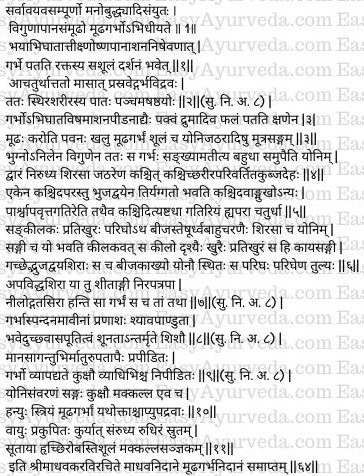Madhava Nidana Chapter 64 Mudhagarba Nidanam

This article explains Madava nidana 64th chapter “Mudhagarba Nidanam”. Causes, pathology and symptoms of Mudhagarba are explained in this chapter. Mudhagarba means obstructed labor.
Table of Contents
Definition
Mudha Garbha -The condition in which the foetus whose body parts have been properly and completely formed (matured), and has been endowed (associated) with mind, intellect etc, gets obstructed in the birth passage due to the influence of aggravated apana vata is called as mudhagarbha.
Read – Mudha Garbha – Obstructed Labor, Ayurveda Perspective
Garbhapata

Sudden fear, injury (assault), excessive consumption of foods and drinks which are sharp and hot in nature causes falling off (abortion) of the embryo accompanied with pain and heavy bleeding. (This condition is known as garbhapata – miscarriage or abortion). (1)
Types of Garbhapata
Garbhasrava – If this (premature falling off of the embryo) happens within the first four months of pregnancy when the uterine contents are still in fluid state (embryo is in fluid state) it is known as Garbhasrava (abortion).
Garbhapata – If the premature embryo is expelled from the uterus in the fifth or sixth month when the embryo has been developed and the body parts are stable (hard parts), it is known as Garbhapata (miscarriage). (2)
Read – Garbhasrava, Garbhapata – Meaning, Causes, Ayurveda Treatment
Garbhapata hetu
Causative factors for miscarriage
Just as a ripe fruit fall from a tree, the embryo too falls off suddenly (garbhpat takes place) by trauma on the abdomen, consumption of unhealthy foods, and unnecessary massage or pressure over abdomen.
Nature and symptoms of Mudhagarbha
If vata (apana vata) gets increased (goes out of balance), it causes difficulty in delivery. This condition is accompanied with pain in the vagina (uterine passages), abdomen etc and urinary obstruction. (3)
Read – Diet And Lifestyle For Women In Ayurveda
Mudhagarbha Ashta Vidha
Eight kinds of Mudhagarbha
Väta undergoing increase affects the foetus and creates many kinds of abnormal presentations of the foetus inside the vagina (in the vaginal tract). Among such abnormal presentations of the foetus, eight main presentations are mentioned here. They are –
- obstruction of the mouth (opening) of the uterus by the face of the foetus
- obstruction of the opening of the uterus by the abdomen of the foetus
- obstruction of the mouth of the uterus by the back of the foetus, curved and shortened
- obstruction of the mouth of the uterus by one shoulder of the foetus
- obstruction of the mouth of the uterus by both the shoulders of the foetus
- obstruction of the mouth of the uterus by the body of the foetus placed in transverse position
- obstruction of the mouth of the uterus by the face of the foetus bent down (foetus faces downwards)
- obstruction of the mouth of the uterus by the flanks of the foetus (3-5)
Four special types of presentations of the foetus
Some other authorities enumerate four other kinds of presentations of foetus. They are named as Kilaka, Pratikhura, Parigha and Bijaka.
Kilaka / sankilaka – It is the presentation in which the foetus blocks the mouth of the uterus / vagina, like a wedge, by raising its hands, feet and head upwards.
Pratikhura – In this presentation we can see the bending of the body of the foetus like a horse’s hoof with hands, feet and head of the foetus obstructing the opening of the uterus / vagina. Even in this, the body becomes obstructed.
Bijaka – It is a presentation in which both the shoulders (hands) and head cause obstruction to the opening of the uterus (which may prolapse).
Parigha – Here we can see the transverse position of the foetus, like the bolt of a door inside the uterus (obstructing the vaginal passage / uterus). (6)
Read – Anomalies, Defects In Fetus, Ayurvedic Treatment
Prognosis of Mudha Garbha
The woman in labour who is unable to keep / hold her head straight (in position) i.e., the head keeps falling to one or the other side, whose body has become cold, who is devoid of (natural) shyness and on whose abdomen has blue prominent veins would kill the child and that child would kill her (mother). (7)
Mruta Garbha
Absence of movements of the foetus and cessation of labour pains, blackish yellow or bluish yellow discolouration of the skin, bad smell in her breath and swelling (abnormally swollen abdomen) are the symptoms of the woman whose foetus is dead inside (the womb). (8)
Reason for the death of the foetus
Due to mental disorders, external injury, excessive physical strain for the mother and as an effect of many diseases, the foetus would die inside the womb (uterus). (9)
Read – Monthly Development Of Fetus – Ayurvedic perspective
Prognosis of Mudhagarbha
Yonisamvaraṇa (total obstruction of the uterus), kukṣisanga (obstruction of the foetus inside the abdomen / womb or dead foetus staying in the uterus for long time) and makkalla (pain after delivery) developing as complications of mūḍhagarbha and other complications are going to kill the woman. (10)
Makkalla
(A condition in which abnormally increased vata causes obstruction of the blood being discharged after delivery and causes pain in the region of the heart, head and urinary bladder is called Makkalla.) Thus ends the chapter on Mudha Garbha.
Thus ends the chapter on Mudhagarba Nidanam in Madhava Nidana text written by Acharya Madhavakara.











